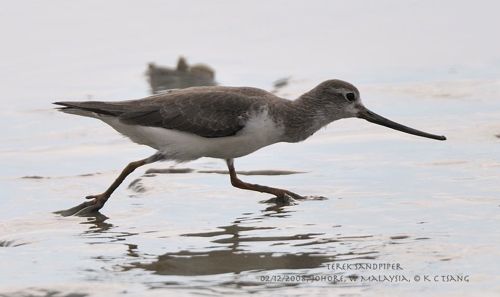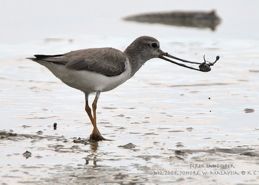KC Tsang wrote after his trip to nearby Johor, Malaysia in early December 2008:
“The Terek Sandpiper (Xenus cinereus) is an amazingly active feeder – I was observing it sprinting from one position to another, from distances of three to ten feet. It also changes directions in a very abrupt manner… On having ascertained that the prey is below the mud surface, the bird would then jab it’s long up-curved bill into the soft mud, turning and twisting it as it searches for tiny crabs.
“On having caught the prey, it would then yank it out of the mud and proceed to bash it on the mud, then to vigorously shake off the mud sticking to it. After having cleaned the prey and got rid of most of the crab’s legs, it would then proceed to swallow it whole.
“It is amazing that the bird is able to swallow the crab whole. It seems to be able to stretch open the base of its bill to accommodate the whole crab.”
According to Wells (1999), the Terek Sandpiper takes mainly small crabs and polychaete worms. On the other hand, Gils & Wiersma (1996) report that it also takes insects, small molluscs, crustaceans and spiders. It has a characteristic way of feeding – moving rapidly and changing directions all the time, often wobbling about and pecking at sand or water surface or even probing into the substrate. The bird also chases surface preys and often washes prey before swallowing.
Images by KC Tsang, photographed in Johor, Malaysia.
References:
1. Gils, van J. & P. Wiersma, 1996. Family Scolopacidae (Sandpipers, Snipes and Phalaropes. In del Hoyo, J., A. Elliott & J. Sargatal (eds.), Handbook of the birds of the world. Vol. 3. Hoatzin to Auks. Lynx Editions, Barcelona. Pp. 444-533.
2. Wells, D.R., 1999. The birds of the Thai-Malay Peninsular. Vol. I, Non-passerines. Academic Press, London. 648 pp.












One Response